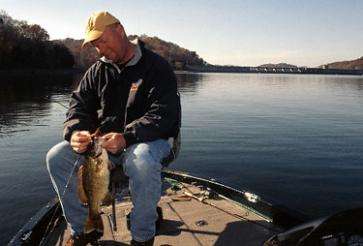
First it was the snow, now it’s the rain. It’s been pouring here in Tennessee for three or four weeks, and, from what I see on TV, the rest of the country isn’t any better off. But, that doesn’t mean we can’t catch ’em. We just have to look at things a little differently.
That starts with understanding what’s happening in the water. There’s a ton of warm water entering the lakes through the creeks. This is causing even the clearest lakes to turn murky and stained. That changes the smallmouth fishing.
The baitfish are still moving back into the creeks, but they’re hanging out in different places. Mostly you’ll find them along the flats bordering the channel for about 20 yards on either side of where it runs up against the bank.
Under these conditions, my crankbait choices from the last blog won’t do you much good. They tend to run too fast. The fish have trouble finding and catching them. That means a lot of fishless hours, even on the best places. A better lure is a spinnerbait.
I like a tandem-bladed bait with a small, nickel Colorado blade on the front and a big gold willowleaf blade in the back. I almost always go with a 1/2- or 3/4-ounce weight. My favorite colors are dark; I call them worm colors.
That might surprise some of you. It seems like we all reach for a bright spinnerbait as our first choice. But not me. I want something dark that makes a good profile in dark water. That makes sense if you stop and think about it. We throw dark jigs in this stuff and dark plastics. Why not a dark spinnerbait? It’s really nothing more than a jig with blades following it.
You’ll find most of the fish up on the flats alongside the channel, not in the channel itself. They’re feeding, no matter how bad the water looks to us humans. We’re catching most of our fish anywhere between 3 and 15 feet deep. I’m sure the same thing is true for the rest of the country.
It’s really important to slow roll your lure. We like to crank them just fast enough to keep them moving, but not fast enough to get them off the bottom. They should bang into rocks, stumps and other stuff on the bottom.
t’s also really important to make lots of casts into the same area. You can’t see very well beneath the surface, so you never know where the next rock or stump might be located. Sometimes the direction your lure is traveling can make a big difference. I’ve seen days where changing directions will turn a miserable bite into a hot bite.
Don’t give up just because of the rains and the muddy water. You can still catch them if you go about it the right way and think positive.
Until next time, if you have any questions or comments, I’d love to hear from you. Please e-mail me atStephen@thesmallmouthguru.com.





